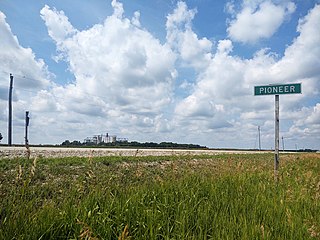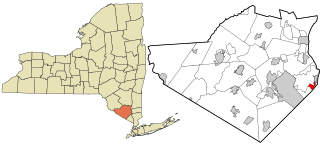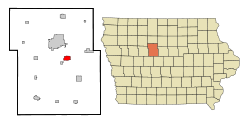
Webster County is a county in the U.S. state of Iowa. As of the 2020 census, the population was 36,999. The county seat is Fort Dodge. The county was established in January 1851, one of 43 counties established by a legislative package. This county was named after Daniel Webster, an American statesman noted for his moving oratory.

Henry County is a county located in the U.S. state of Iowa. As of the 2020 census, the population was 20,482. The county seat is Mount Pleasant. The county was named for General Henry Dodge, governor of Wisconsin Territory.

Carbon is a city in Douglas Township, Adams County, Iowa, United States. The population was 36 at the 2020 census.

Exline is a city in Appanoose County, Iowa, United States. The population was 160 in the 2020 census, a decline from 191 in 2000.

Rathbun is a city in Appanoose County, Iowa, United States. The population was 43 at the time of the 2020 census.

Fraser is a city in Dodge Township, Boone County, Iowa, United States. The population was 101 at the time of the 2020 census. It is part of the Boone, Iowa Micropolitan Statistical Area, which is a part of the larger Ames-Boone, Iowa Combined Statistical Area. The city is located along the Des Moines River.

Pioneer is an unincorporated community in Humboldt County, Iowa, United States. The population was 4 at the time of the 2020 census, and elected to unincorporate as a municipality in 2020.

Lucas is a city in Lucas County, Iowa, United States. The population was 172 at the time of the 2020 census.

Oskaloosa is a city in, and the county seat of, Mahaska County, Iowa, United States. In the late nineteenth and early twentieth century, Oskaloosa was a national center of bituminous coal mining. The population was 11,558 in the 2020 U.S. Census, an increase from 10,938 in 2000.

Bussey is a city in southeast Marion County, Iowa, United States. The population was 387 at the time of the 2020 census.

Curlew is a city in Palo Alto County, Iowa, United States. The population was 37 at the time of the 2020 census.

Mallard is a city in Palo Alto County, Iowa, United States. The population was 257 at the time of the 2020 census.

Plover is a city in Pocahontas County, Iowa, United States. The population was 50 at the time of the 2020 census.

Saylorville is a census-designated place (CDP) in Polk County, Iowa, United States. The population was 3,301 at the 2010 census. It is part of the Des Moines–West Des Moines Metropolitan Statistical Area. The Saydel Community School District is located in this area, as is the unincorporated community of Marquisville.

Douds is a census-designated place (CDP) in Van Buren County, Iowa, United States. The population was 165 at the 2000 census.

Badger is a city in Webster County, Iowa, United States. The population was 522 at the 2020 census.

Callender is a city in Webster County, Iowa, United States. The population was 368 at the time of the 2020 census.

Fort Dodge is a city in, and the county seat of, Webster County, Iowa, United States, along the Des Moines River. The population was 24,871 in the 2020 census, a decrease from 25,136 in 2000. Fort Dodge is a major commercial center for North Central and Northwest Iowa. It is located on U.S. Routes 20 and 169.

Lehigh is a city in Webster County, Iowa, United States. The population was 395 at the time of the 2020 census.

Fort Montgomery is a hamlet in Orange County, New York, United States. The population was 1,571 at the 2010 census. It is part of the Poughkeepsie–Newburgh–Middletown, NY Metropolitan Statistical Area as well as the larger New York–Newark–Bridgeport, NY-NJ-CT-PA Combined Statistical Area.






















